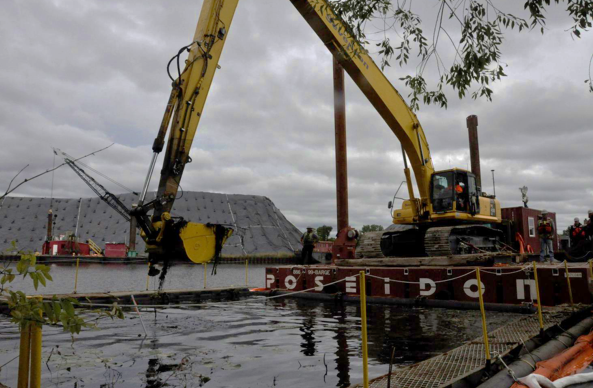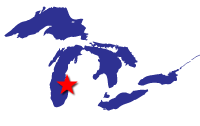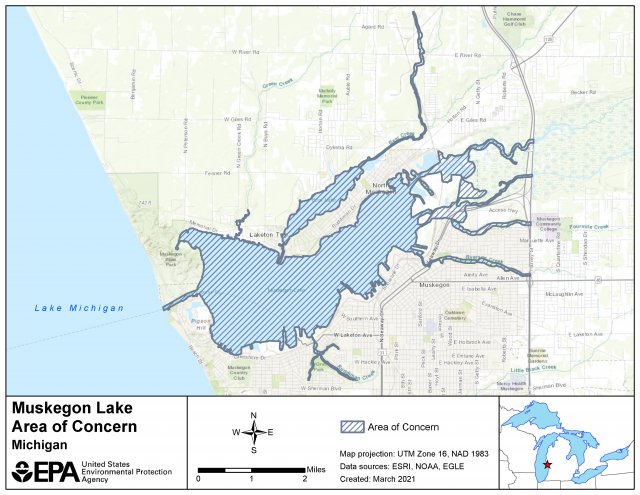Muskegon Lake AOC - Delisted
Contact: Suse LaGory
(Lagory.susanna@epa.gov)
312-886-5253
Latest News
- EPA and EGLE Celebrate Removal of Muskegon Lake Area of Concern from List of Most Environmentally Degraded Areas in the Great Lakes
- Back from the Brink: A Muskegon Lake Film
Overview
Muskegon Lake is a 4,149-acre drowned river mouth lake that flows into the eastern shore of Lake Michigan. It was designated as an AOC in 1987 due to ecological problems like:
- Contaminated sediment (petroleum hydrocarbons, mercury, lead, other heavy metals, oil, PAHs, and PCBs).
- Excessive fill and loss of natural shorelines.
- Large-scale impacts to critical wetlands.
- High levels of nutrients, solids, and toxic substances entering the lake.
- Degradation of water quality.
- These issues were caused by:
- Historical industrial pollutants entering the lake.
- Shoreline development and hardening.
- Historical sawmill debris, foundry sand and slag filling open water and coastal wetlands.
- Localized groundwater contamination.
Thanks to the work of the EPA and other federal, state, and local partners, the Muskegon Lake community is experiencing benefits from restoration and remediation efforts in the AOC. The Great Lakes Restoration Initiative and the Great Lakes Legacy Act largely funded these efforts. As a result, residents and visitors are increasing their recreational use of the rivers and Muskegon Lake, tourism is up, and property values have grown, and the AOC was delisted in September 2025.
Beneficial Use Impairments
Beneficial Use Impairments are designations that signify severe environmental degradation in AOCs. Removing BUIs indicates cleanup and restoration progress are being made in an AOC. There are 14 possible BUIs an AOC can have designated, and once cleanup work is complete and monitoring has demonstrated sufficient environmental health improvements, BUIs are gradually removed. Originally, the Remedial Action Plan for Muskegon Lake AOC identified nine BUIs. As of September 2025, all BUIs are removed and the AOC is delisted.
BUIs removed include:
- Restrictions on Dredging Activities (pdf) – Removed September 2011
- Restrictions on Fish and Wildlife Consumption (pdf) – Removed February 2013
- Beach Closings (pdf) – Removed August 2015
- Restrictions on Drinking Water Consumption, or Taste and Odor (pdf) – Removed February 2013
- Degradation of Aesthetics (pdf) – Removed October 2021
- Degradation of Fish and Wildlife Populations (pdf) – Removed May 2023
- Loss of Fish and Wildlife Habitat (pdf) – Removed May 2023
- Eutrophication or Undesirable Algae (pdf) – Removed March 2024
- Degradation of Benthos (pdf) – Removed October 2024
- General information about BUIs: Beneficial Use Impairments for the Great Lakes AOCs.
Remediation and Restoration Work
As of September 2021, project partners have completed all on-the-ground projects, or Management Actions, at the Muskegon Lake AOC. This is due to the collaboration of numerous federal, state, and local partners.
The Great Lakes Legacy Act provided funding for four sediment remediation projects in the AOC. Project partners remediated over 190,000 cubic yards of sediment contaminated with PCBs, PAHs, heavy metals, mercury, and petroleum. These projects helped restore habitat for benthic invertebrates and fish and wildlife. The total cost of the sediment remediation projects was approximately $47 million. EPA provided over $30 million in funding under the GLLA cost-share program, while state and local partners provided an additional $16 million through in-kind and cash contributions.
Partners completed seven habitat restoration projects in the AOC, restoring approximately 134 acres of habitat and over 6,000 linear feet of shoreline. These restored areas include nearly 100 acres of open water and emergent wetlands, as well as aquatic fish habitat and upland habitat for native plants. Additionally, project partners removed over 110,000 tons of logging-era sawmill debris from the lake, restoring benthic habitat for bottom-dwelling invertebrates and open-water habitat for fish and wildlife populations. These projects, which cost a total of $22.9 million, have helped create a healthier and more vibrant lake ecosystem that can successfully support native fish and wildlife populations. They will also add significant socioeconomic value to the surrounding communities.
More information:
- Documents on Restoring the Muskegon Lake AOC
- Remediation and Restoration Projects for Muskegon Lake AOC
Sediment Remediation Project Highlight: Ryerson Creek Great Lakes Legacy Act

The Ryerson Creek Great Lakes Legacy Act project was the final sediment remediation project for the Muskegon Lake AOC. Completed in November 2020, this project focused on remediating sediment in the creek that was contaminated with PAHs, heavy metals, and petroleum. The sediment was largely contaminated due to sewer overflows and legacy industries even though the creek had low baseline pollution levels.
10,600 cubic yards of sediment were mechanically dredged, and 2,000 tons of mill debris were removed. Additionally, clean sand was placed as a cover over the entire 2-acre area to help restore benthos in the lake and decrease contamination in the surrounding shoreline.
EPA completed the $6.6 million cleanup in collaboration with the Michigan Department of Environment, Great Lakes and Energy (EGLE), Muskegon County, and an industry partner. EPA provided $4.3 million through the GLRI, and EGLE provided $1.2 million in cash and in-kind contributions, with the remainder provided through in-kind services from Muskegon County and the industrial partner.
Restoration Project Highlight: Lower Muskegon River Habitat Restoration
In 2020, federal and local partners completed a habitat restoration at a site in the Muskegon River a half mile upstream from the Muskegon Lake. The site was a former celery farm that was separated from the river by three concrete dikes. The National Oceanic and Atmospheric Administration completed this project in collaboration with a Regional Partnership with the Great Lakes Commission under a $3.1 million GLRI grant. The project was locally managed and implemented by the West Michigan Shoreline Regional Development Commission.
Restoration work for this project involved removing the dikes to reestablish hydrological connection between the river and the lake and increase fish passage. Additionally, over 53 acres of emergent wetland were restored by creating emergent wet meadow, shrub, and floodplain forested wetlands. Partners then established habitat for fish, bird, and reptile populations by installing over 34,000 native plants and 160 habitat structures. This project also removed 5.3 acres of fill and softened 2,700 linear feet of shoreline.
Ultimately, these upgrades will enhance the Muskegon Lake fishery and increase recreation opportunities like canoeing and kayaking on the river.



